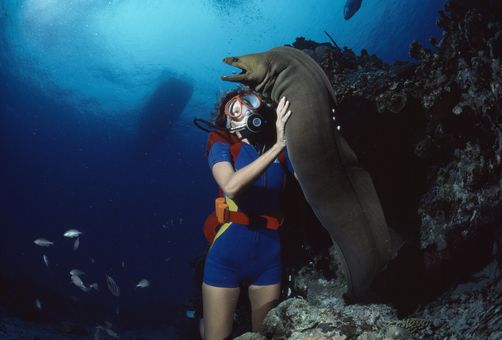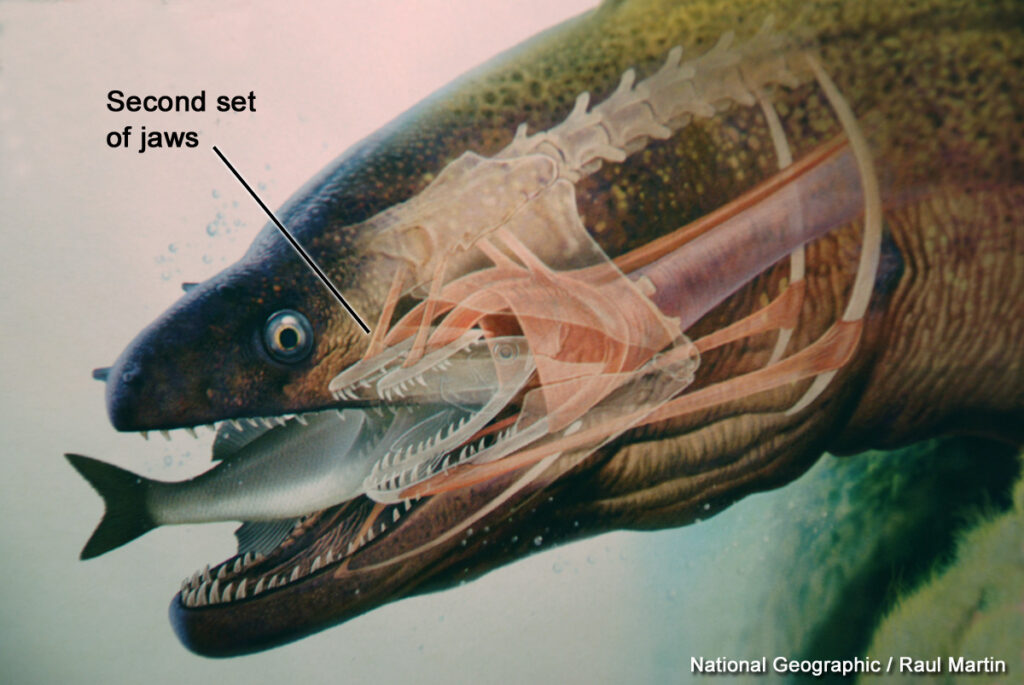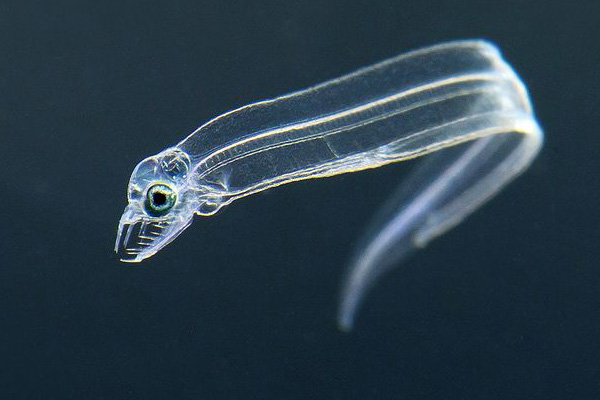Morays belong to the family Muraenidae which also include Ribbon eels Rhinomuraena. Altogether there are over 200 species in 15 genera found although the world in tropical and subtropical seas. Most Moray eel species mainly found in marine waters with few exceptions to several species that are also seen in brackish waters for example Mud Morays (Gymonothorax tile) and (Gymnothorax polyuranodon). these two species are also known to tolerate Freshwater and live entirely in freshwater in captive conditions.
Moray eels species come in a wide array of colors and patterns. But all morays lack Pectoral and Pelvic fins. They have a long dorsal fin that continues down their body merging with their caudal fin. Morays have poor vison and relay on Chemoreception and their keen sense of smell to find pray, their nostrils have been Developed into two tubes that sit on the top of their mouth. Moray eels are also found in array of sizes The smallest species been the Snyder’s moray eel (Anarchias leucurus) which only grows up to just under 5in in Length. And the Largest species in this family is the Giant moray eel (Gymnothorax javanicus) measuring over 9.8 feet in length and weighing over 30 kg in weight, some Giant moray eels are even to known to like more than 15years, in general the larger moray eel species tend to have a longer lifespan.

One main characteristic that all morays have in common is their second set of jaws apart from their oral jaws they also have a set of Pharyngeal jaws which sits in the back of their throat and shoots forward when the oral jaw grabs on to a pray and helps them pull it into their mouth, morays are the only animals known to do this (apart from fictional characters from movies like Xenomorphs

Recent studies at the Smithsonian National Museum of Natural History conducted by Rita Mehta, an associate professor in the Department of Ecology and Evolutionary Biology at the University of California Santa Cruz (UCSC) and co-author Kyle Donohoe, a research assistant at the UCSC Pinniped Cognition and Sensory Systems Laboratory.
Based studies where moray eels hunt in shallow water during low tides for stranded fish and crustaceans on slithering from the sea to hunt their prey during low tide, and knowing about the mechanics of the pharyngeal jaws, it just made sense that if moray eels were able to capture prey in the intertidal or on land, they could also swallow their prey on the land without relying on water.
Training Snowflake moray eels (Echidna nebulosa) With help of it’s Pharyngeal jaws it was able to feed out of water and sallow down its pray in the same way by the recoil of the Pharyngeal jaws, these jaws are so strong that its enough to help moray eel swallow their pray on land as the same speed it would take underwater.
the study took six years tanks had installed platforms and ramps that were above water for the moray eels to get above water more easily, the mucus coating on morays’ skin protects the eels from drying out They were trained to climb up the ramps by using piece of squid.
Many people misidentify moray eels with sea snakes many local fisherman in Sri Lankan call them “nai”. But unlike snakes moray eels don’t have scales on their skin what they do have on their skin is microscopic cells called Goblet Cells which produce the mucus that covers their entire body this mucus cover helps protect themselves from them abrasions caused by the sharp edges of corals.
Moray eels are Primarily nocturnal but can be seen out swimming through out the day as well but most of the time during the day the mostly hide in-between corals, caves and rocks crevices, with just their heads out to generate oxygen through their gills unlike other eels, morays don’t have operculum flapping, they have a circular opening where the water is flown out of, Moray eels are primarily ambush hunters. Some individuals have been observed hunting together with Pharyngeal jawss out in open waters.

This is an Extremely Remarkable Hunting Groupers actively visit moray eels at their resting places during the day and Grouper makes of visual contact by engage to shaking the head at high frequency (3—6 shakes per second) directly in front of the moray eel, usually few inches away from the moray’s head, The Morays respond to the signal by leaving their crevice to join the grouper in hunting for pray through the reef. Both the morays eel and groupers gain a more success in finding pray from the coordination, Groupers have even observed guiding moral eels to prey hidden in coral crevices which the groupers cannot get into.
Moray eels are mainly opportunistic feeders. feeding on fish, octopus, mollusks, crustaceans, and even capable of eating lionfish and small puffers. But some species like the Snowflake moray (Echidna nebulosa) have evolved into feeding on crustaceans, mollusks and other hard shelled animals, thus they have evolved blunt teeth which helps them to crush their pray.
When moray eels are threated they open and flash their mouths exposing the sharp backward facing teeth. Such an action may frighten a moray eel to lash out and bite in self-defense. Like all other “dangerous” sea creatures, they usually do not bite unless first provoked. Moray eels have a bad reputation among divers. Generally, they are not known to be aggressive to divers unless disturbed or threated. Moray eels are highly intelligent creatures some divers have even befriended individual morays in frequent dive spots.
Moray eel are solitary creatures even during reproduction adult female moray eels lay eggs at a spawning site. And the male fertilizes the eggs after the eggs are fertilized there is no parental care and when the eggs hatch the larva Transparent Larval Stage of Moray eels known as (Leptocephalus)

Check this out – Jawed vs Jawless | Reasons behind the low diversity of jawless fishes compared to jawed fishes in the world.







